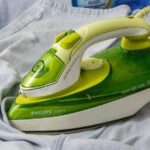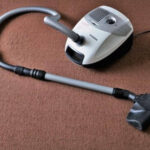Every once in a while, pillows require a through wash to remove dirt and dust, pet dander, body oils, sweat, dead skin cells and everything else that keeps good hygiene and dust mites at bay.
But washing pillows does not sound as hassle free as laundering sheets and pillow cases. It is also not the same as cleaning blankets. Thus, you might be wondering whether you can wash pillows in the washing machine.
Without a doubt most pillows can go into the washer and dryer. Even so, you have to look at the care instructions to avoid making a careless mistake.
Inspect the Care Tag
To make sure that your pillow is suitable for machine washing, remove the pillow case first and set it aside. Next, inspect your pillows around all the four seams to find the care label. Read the instructions carefully and determine the recommended method for washing.
A typical care label shows whether you should machine-wash, hand-wash, or hand over your pillow to professionals for dry cleaning. Some tags also explain whether you can use more than one of these care methods for your down pillow
If the tag indicates that your pillow is machine washable, it also delves further into more specific instructions. For example, the manufacturer might state that you should wash the pillow in warm water and mild soap detergent in a normal or gentle cycle.
Some of this information can be in words and some of it expressed symbolically. We explain how you can understand washer symbols in this our article for putting a king comforter in a washer.
Since a washer goes hand in hand with a dryer, most care tags also provide this information as well. This should help you to determine whether and how to tumble dry your pillow.
What if a pillow is not machine washable…
If your pillow is made of memory foam or a different type of sensitive material, then the care tag will tell you that it is not machine washable.
For example, I have one memory foam pillow and the care tag instructions indicate that I should machine wash the cover only. It further states that dry cleaning is recommended method. I also have another one that provides instructions for hand washing.
According to expert information sought by marthasteward.com from the American Cleaning Institute, it is important to wash pillows twice per year. On top of that, feather, polyester, cotton and fiber pillows can be washed in the machine.
Choosing the Right Washer for Your Pillows
Most pillows can go to a regular washer but a large machine works best. It offers enough space to accommodate two pillows at ago, which makes the machine balanced.
Another thing to consider is the design of your machine. Front loaders and top loaders without an agitator are the best. An agitator can ruin certain types of laundry, including pillows.
How to Wash Pillows

Depending on the information provided on the care label of your pillows, you can either hand-wash them or use your machine.
Machine Washing
Step 1: Remove the pillow case from your pillow and ensure that all the seams of your pillow are intact. This is important because you do not want your pillow to release some of the filling into the washer during the wash season. Besides ruining the pillow, this can also damage your machine.
Step 2: Set the machine on a gentle cycle and use warm water and mild detergent. This instructions can vary depending on the information on your pillow’s care tag.
Step 3: Rinse the pillow in cold water and spin to remove excess water from the filling. This is important because most pillows can take a very long time to dry.
Step 4: If drying your pillow in a dryer is recommended, toss it in the machine and select the appropriate cycle. In most cases, manufacturers recommend tumble drying on low. Keep checking after every few minutes to fluff so that the filling does not for lumps. If your pillow cannot go to the dryer, a
Hand Washing
If your pillow’s care label provides the option for handwashing, it is best that you prioritize it. Handwashing gives you more control during the washing process. As such, you are able to prevent lumpiness that can occur in the washing machine.
Step 1: Begin by removing the pillow case to wash it separately, either by hand or in the washing machine.
Step 2: Add warm water and detergent in a large sink or tub. Use your hands to swirl the water and detergent properly so that you can end up with a consistent solution.
Step 3: Submerge your pillow in the solution completely. Let the pillow’s filling take in as much solution as possible. Begin to massage your pillow gently to avoid ruining the filling. If it is difficult to clear dirt from the cover, you can use a soft brush and detergent. Scrub gently until you remove all the dirt.
Step 4: Drain dirty water from tub or sink and add enough warm water to submerge the pillow again. Massage the pillow so that it can release more dirty and soapy residue to the water. Repeat this step until the pillow stops to release dirt and soap sudsy. Soapy residue attracts dirt easily if left on your pillow.
Step 5: Rinse the pillow in cold water and press out as much water as possible. Ensure that press or wring out water gently to avoid displacing the filling or ending up with a lumpy pillow.
Step 4: Dry your pillow in the sun or as instructed on the care label. It is important to make sure that your pillow is completely dry in the inside. Otherwise it can provide a good environment for molds.
How to Spot Clean a Pillow
In between your pillow washes, you might need to spot clean it. There are also pillows that come with spot clean only instructions. In such a case, you cannot submerge them in water or take them through a cycle in the washer.
Mostly, spot cleaning should be easy. Wring a clean microfiber cloth in a solution of water and detergent. Next, use it to scrub one spot at a time until the stain is cleared.
To remove tough stains, use vinegar and baking soda to form a paste. Use a toothbrush to apply the paste on the stain. Scrub gently with the brush until the stain is cleared.
There are tougher stains that might need you to use bleach. If it gets to that, ensure that you choose the right bleach for your pillow. Additionally, avoid using bleach on a pillow with a care label that discourages bleaching explicitly.
How to Maintain and Care for Pillows
Since washing pillows is not something you do regularly, it is best to maintain and care for them. This can help to control how dirty they get. Further, they can serve you for much longer without becoming lumpy or producing bad odor.
Use pillow cases always: Pillow cases act as a protective barrier for your pillows. They prevent them from collecting dust and dirt from sweat, dead skin cells, body oils and hair oils. The beauty of using pillow cases is that you can wash them weekly, or change them at any point of the week.
Cover your head when sleeping: Hair collects a lot of residue from moisturizers and shampoo. Ultimately, these products end up on your clothes and everything else it comes into contact with. Head coverings such as satin bonnets are good for preventing your hair from drying out and for protecting your pillows.
Air dry your pillows: It is important to air or sun dry your pillows sometimes. This keeps them fresh and free from bad odor.
Fluff pillows regularly: Fluffing pillows helps them retain their original shape and texture.





